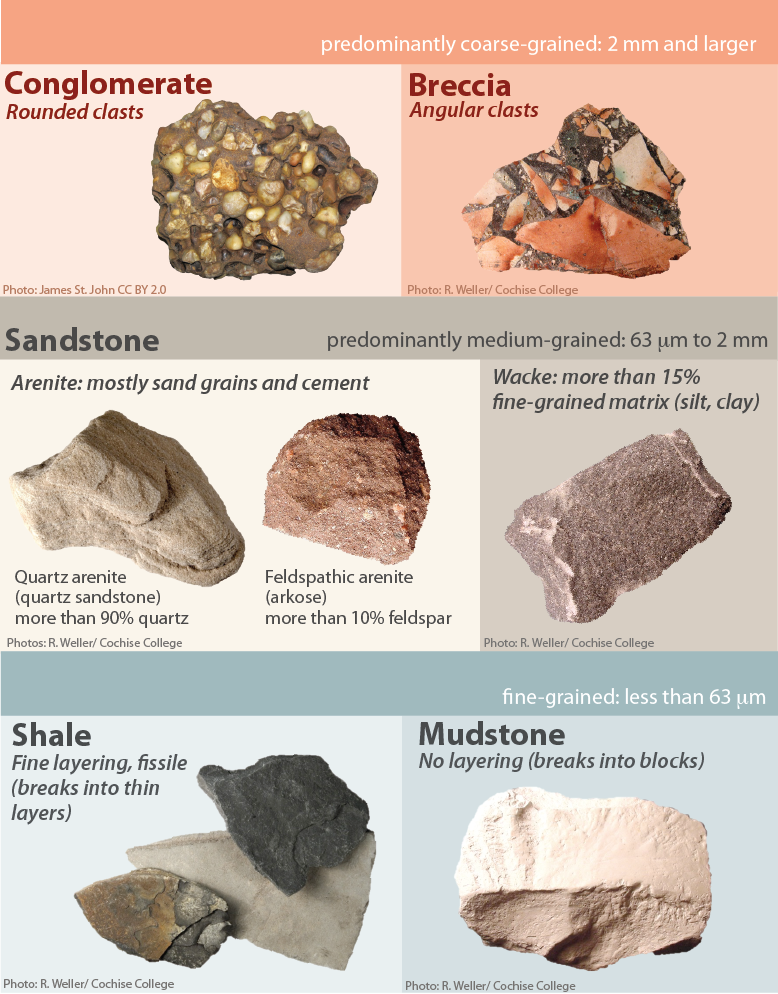This scale of roundness from angular to well-rounded is illustrated in Figure. Terms in this set 65 What can geologists learn by sequences of sedimentary rocks-How climate changed over time.

Sedimentary Textures And Classification Of Clastic Sedimentary Rocks Sedimentary Rocks Sedimentary Geology
From 39 to 625.

. Pieces of broken rock produced by physical weathering are called clasts. An important characteristic of the clastic sedimentary rocks however is that all have clastic textures. The smaller ones tend to be composed of a single mineral crystal and the larger ones are typically composed of pieces of rock.
Sorting describes the size range of clasts in sediment Poorly sorted wide range from GEOL 1001 at Louisiana State University. What are 3 examples of clastic sedimentary. All well-rounded clasts are also spherical.
Clasts comprising the auto-breccia are termed clinker. A well-sorted clastic rock is made up of a wide range of particle sizes. The terms used to describe the size range of clasts in a sedimentary deposit or rock.
Clastic rocks are classified and named according to texture clast size sorting and rounding and mineral composition. Sand as you may guess forms sandstone. Silt refers to particles that have a diameter between 062 and 0039 millimeters.
Term used to describe the size range of clasts in a sedimentary deposit or rock. 1- Sketch and describe how sediments are classified according to size shape and sorting of clasts. Angular pebbles and cobbles with sand and finer particles between the larger clasts - Sandstone.
Sandstone is medium-grained meaning its fragments are between 116 mm and 2 mm. From 625 micrometers to 2 millimeters. Conglomerate consists of a single grain size.
2- Sketch and describe what happens to clastic sediment as it becomes buried and converted into rock lithified. From 64 to 256 mm. Sand-sized particles of varying mineral content - Siltstone.
However the term can also be used to refer to a family of sheet silicate minerals. Rounded pebbles and cobbles with sand and finer particles between the larger clasts - Breccia. By virtue of being derived from the flow core they have the same geochemical and petrographic character as the core although they are often more oxidized.
Silt-sized particles mostly containing quartz. To describe the shape of clasts in a sedimentary rock or grains in a unconsolidated sediment geologists use the term roundness. That is the grains are not interlocking- they are held together as an aggregate by a cement.
From 2 to 64 mm. If the fragments are rounded they form conglomerate and if they are angular they form breccia. For any geologist describing sediments and clastic sedimentary rocks it is not only the size of the clasts that is important for classification but also the range of sizes and shapes.
Greater than 256 millimeters mm Cobble. The term clay is used to classify particles smaller than 0039 millimeters. The term used to describe the size range of clasts in a sedimentary deposit or rock is _____.
3- Sketch and describe the types of layers that. Various types of clasts are shown in Figure 512 and in Exercise 53. Sandstone is largely composed of.
As boulders are moved down stream and weathering breaks them into smaller clasts they first become cobbles then pebbles and finally _____ or smaller particles. Grain size range metric Boulder. Sorting Identify the factors that strongly influence the size shape andor sorting of.
A clast is a fragment of rock or mineral ranging in size from less than a micron 1 too small to see to as big as an apartment block. Silt forms fine-grained siltstone with fragments between 116 mm and 1256 mm. And describe the natural cement that are common in sedimentary rocks.
Individual clinkers range in size from a few centimetres to metres across.

9 1 Clastic Sedimentary Rocks Physical Geology First University Of Saskatchewan Edition

0 Comments